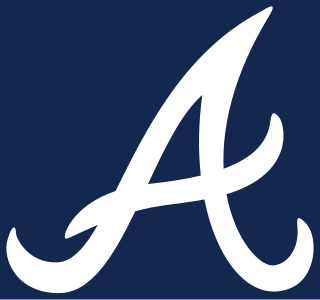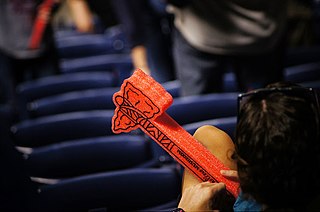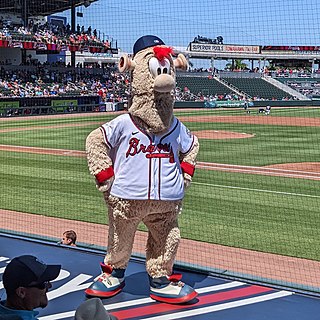
The Atlanta Braves are an American professional baseball team based in the Atlanta metropolitan area. The Braves compete in Major League Baseball (MLB) as a member club of the National League (NL) East Division. The Braves were founded in Boston, Massachusetts, in 1871, as the Boston Red Stockings. The club was known by various names until the franchise settled on the Boston Braves in 1912. The Braves are the oldest continuously operating professional sports franchise in North America.

A tipi or tepee is a conical lodge tent that is distinguished from other conical tents by the smoke flaps at the top of the structure, and historically made of animal hides or pelts or, in more recent generations, of canvas stretched on a framework of wooden poles. The loanword came into English usage from the Dakota language and Lakota language.

Harry Christopher "Skip" Caray Jr. was an American sportscaster, best known for his long career as a radio and television play-by-play announcer for the Atlanta Braves of Major League Baseball. He was the son of baseball announcer Harry Caray, and the father of St. Louis Cardinals play-by-play announcer and former fellow Braves broadcaster Chip Caray; another son, Josh Caray, is the play-by-play announcer for the minor league Rocket City Trash Pandas.

Atlanta–Fulton County Stadium, often referred to as Fulton County Stadium and originally named Atlanta Stadium, was a multi-purpose stadium located in Atlanta, Georgia. The stadium was home of the Atlanta Braves of Major League Baseball from 1966 until 1996 and the Atlanta Falcons of the National Football League from 1966 until 1991. It was built to attract an MLB team and in 1966 succeeded when the Milwaukee Braves relocated from Wisconsin.

Uga is the official live mascot of the University of Georgia Bulldogs. Since Uga I's introduction in 1956, every Uga has been owned by the Sonny Seiler family of Savannah, Georgia.

The Atlanta Chiefs were an American professional soccer team based in Atlanta, Georgia. The team competed in the National Professional Soccer League (NPSL) in 1967 and the North American Soccer League (NASL) from 1968 to 1973 and again from 1979 to 1981. For the 1973 season, the team played as the Atlanta Apollos.
Chief Moccanooga was the former athletic mascot for the University of Tennessee at Chattanooga, until 1996, when the university abandoned the mascot as potentially offensive at the request of the Chattanooga InterTribal Association. Chief Moccanooga was replaced with a mockingbird, the state bird of Tennessee, and the nickname for Chattanooga athletics was changed from 'Moccasins' to simply 'Mocs'.
Bill Shanks is an American sports broadcaster and writer.

Stereotypes of Indigenous peoples of Canada and the United States of America include many ethnic stereotypes found worldwide which include historical misrepresentations and the oversimplification of hundreds of Indigenous cultures. Negative stereotypes are associated with prejudice and discrimination that continue to affect the lives of Indigenous peoples.

Brian Gerald Snitker is an American professional baseball coach and former player who is the manager of the Atlanta Braves of Major League Baseball (MLB). Snitker has been in the Braves organization in different roles since playing in their minor league organization from 1977 to 1980. He became their manager in 2016. In 2021, Snitker led the Braves to a World Series championship.

Since the 1960s, the issue of Native American and First Nations names and images being used by sports teams as mascots has been the subject of increasing public controversy in the United States and Canada. This has been a period of rising Indigenous civil rights movements, and Native Americans and their supporters object to the use of images and names in a manner and context they consider derogatory. They have conducted numerous protests and tried to educate the public on this issue.
This article details the history of the Atlanta Braves, which concerns the evolution of the Major League Baseball team Atlanta Braves over time.

The Boston Braves were a Major League Baseball club that originated in Boston, Massachusetts, and played from 1871 to 1952, after which they moved to Milwaukee, and then in 1966 were relocated to Atlanta, where they were renamed the Atlanta Braves.

The tomahawk chop is a sports celebration most popularly used by fans of the American Florida State Seminoles, Atlanta Braves baseball team, the Kansas City Chiefs American football team, and the English Exeter Chiefs rugby union team. The tomahawk chop involves moving the forearm forwards and backwards repeatedly with an open palm to simulate a tomahawk chopping, and is often accompanied by a distinctive cheer. The Atlanta Braves also developed a foam tomahawk to complement the fan actions.

William Jesus Contreras is a Venezuelan professional baseball catcher for the Milwaukee Brewers of Major League Baseball (MLB). He has previously played in MLB for the Atlanta Braves.

The Atlanta Braves tomahawk chop and name controversy involves the name and tomahawk chop tradition by the Atlanta Braves, an American Major League Baseball (MLB) franchise. Native Americans have been questioning the Braves' mascot choices since the 1970s. Native American objections to the tomahawk chop received much attention during the 1990s and have continued into the 2020s. The Atlanta Braves and their fans continue their overwhelming support of the team name and chop tradition.

Blooper is the official mascot for the Atlanta Braves Major League Baseball team. A big, fuzzy creature with extendable ears, he performs various routines to entertain fans during baseball games at Truist Park, and makes public relation and goodwill appearances for the Braves. While some fans were reluctant when Blooper was introduced, his antics on and off the field soon won fans over in Atlanta.
















